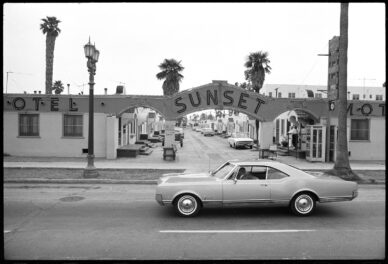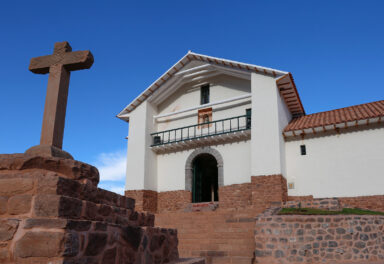In 1949, self-taught photographer Lucien Hervé (1910–2007) traveled from Paris to Marseille to see Unité d’habitation, a housing complex by architect Le Corbusier. Awed by the groundbreaking modern design, Hervé took 650 photographs of it in a single day. When he returned, he mailed them to Le Corbusier. “You have the soul of an architect,” Corbusier replied, and asked Hervé to become his official photographer.
Later, Le Corbusier recounted, “For 40 years I’ve been looking for a photographer able to express architecture.” He had finally found him in Hervé. The two men worked together for the next 16 years—some of Le Corbusier’s most fruitful—until the architect’s death in 1965.
Hervé took thousands of photographs of Le Corbusier’s projects in France and India, as well as portraits of the architect at work and visual studies of objects such as tree trunks or concrete. Once he developed the photographs as contact sheets, he winnowed them down and pasted them into an album, which he and Le Corbusier used when selecting images for publications, lectures, and books.
Getty Publications’ newly released Le Corbusier & Lucien Hervé: A Dialogue between Architect and Photographer by Jacques Sbriglio is the first book to reproduce pages of Hervé’s handmade album. Housed at the Fondation Le Corbusier in Paris since 1965, the album is a vast visual archive of 1,200 cardboard sheets, each carefully sequenced and numbered.
Hervé has long been celebrated for his exceptional artistry as well as his prolific output. (The Getty Research Institute alone holds a collection of over 18,000 of Hervé’s photographic negatives.) The book, however, offers something new: a look at his thought process and editorial choices, as well as his development as an artist.

Pavillon du Brésil, Cité universitaire de Paris, Paris, France, 1953 © FLC-ADAGP
Hervé came to photography by a circuitous route. Born in Hungary, he studied fine art in Vienna and moved to Paris in the early 1930s to work in fashion, then joined the French Communist Party. In 1939, he was drafted as a military photographer, but was captured by the Nazis and sent to prison, where he became very active in the Résistance.
After the war Hervé left politics behind to write for art journals. It was one of his editors, in fact, who suggested he visit Unité d’habitation. Hervé began experimenting with photography, over- or underexposing images or severely cropping them to attain unusual compositions. He followed the work of avant-garde artists such as Piet Mondrian, László Moholy-Nagy, and Alexander Rodchenko, whose stark geometry and abstracted forms enabled him to recognize the same in Le Corbusier’s designs.
When Le Corbusier later asked Hervé how he became a photographer, he replied, “with a pair of scissors.”

Chapel of Notre-Dame-du-Haut, Ronchamp, France, 1950 © FLC-ADAGP
Hervé photographed from multiple vantage points to portray the experience of walking through Le Corbusier’s buildings and create “cinematic visual experiences unfolding over time.”
For example, only a few of Hervé’s images of the iconic chapel at Ronchamp show it head-on. Hervé instead focused on dozens of small details, shooting close-ups of the rough concrete, the geometric shadows cast across the facades, the heavy swoop of the roof, or its strong edges framed by a white sky. These tight shots appear abstract when seen alone, but when viewed in sequence they create a rich total experience of the building, one that wide views would have missed.
Another example: His series taken at Le Corbusier’s small cabin in Roquebrune-Cap-Martin include the landscape and views, a cat lying on the bed, and Mediterranean light infusing the rooms. These multiple views, like film stills, create a narrative that vividly translates the physical experience of being there.
The new book has many beautiful examples of these immersive photographs—some intimate, some transcendent—that bridge the visions of architect and photographer.





Comments on this post are now closed.
Trackbacks/Pingbacks